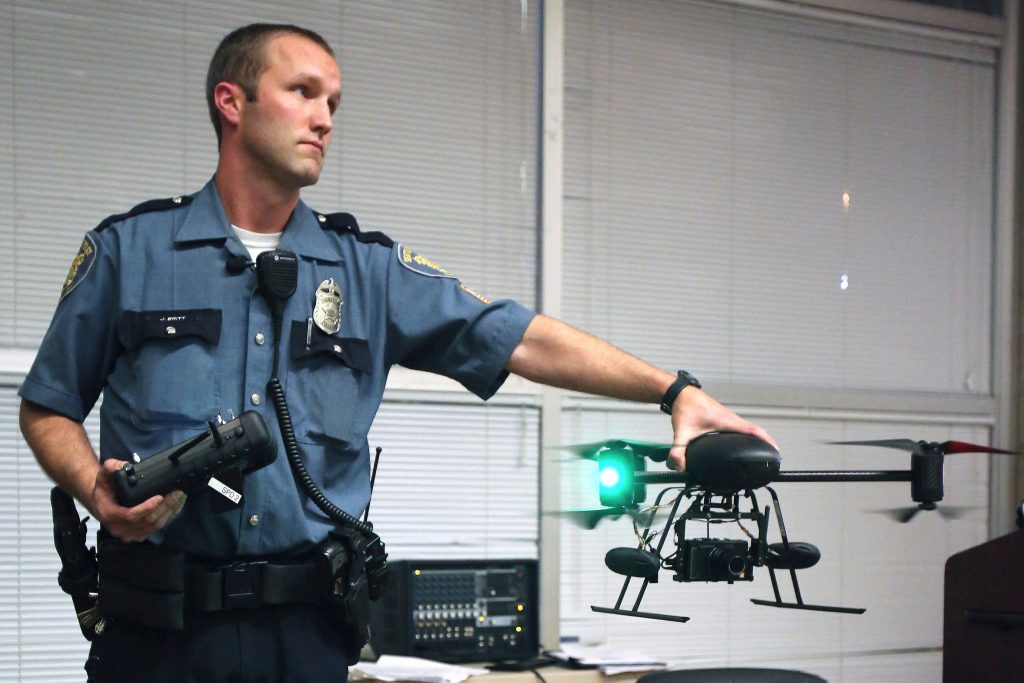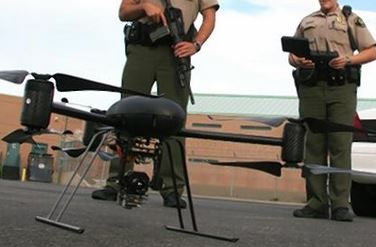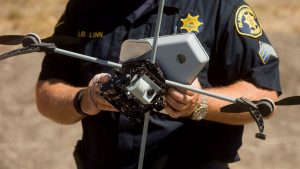Police Drones/UAVs: A Diverse Tool for First Responders
Posted by Extreme Tactical Dynamics on Jun 29th 2019

Whether you consider drones as useful tools with numerous applications or just yet more chaotic clutter in the sky, no one can deny that unmanned aerial vehicles (UAVs) have become part of our daily lives. The public was first introduced to their precision military use some time ago; today tiny mosquito-like drones are commonplace, as well as larger drones that span 3 and 4 feet. But with all new technology, there are pros and cons regarding their use. Most concerns deal with safety factors and their use for illegal surveillance; thus state regulations are needed to manage drones. There is no doubt, however, that UAVs are amazing robotic machines that can save the lives of not only the First Responders who deploy them, but they can make the life and death difference for many who are caught up in an emergency.
A Useful New Technology in Law Enforcement, Fire Fighting, Search & Rescue
Drones are used for all types of missions, and surveillance is at the top of the list. Whether it’s monitoring traffic conditions, the terrain, or crowds, the aerial perspective provides information that is impossible to assess from the ground. Wide areas can be quickly covered, giving law enforcement and firefighters advanced warning. Observing a developing situation gives first responders an edge in preparedness, whether it’s watching a rising river, checking out smoke in a densely forested area, or monitoring traffic movement. Being on top of a situation, literally, gives those in charge a broad view and with it, extra time to make the best decisions about a developing situation. Often those seconds or minutes provide advanced warning and protection for the public.
Search and Rescue Teams can cover vast areas of desolate, unreachable terrain much faster with drones, and when night falls, a search can continue when infrared cameras are mounted on a drone. That was the case on May 9, 2013 when a driver in the province of Saskatchewan ran off the road. Police helicopters searched all day but could not located the man, giving up at dark; it was then that a Draganfly with an infrared camera was sent out. Three heat spots were found around the designated GPS area of the victim who had called for help, but didn’t know where he was. Two large animals and the man were found using the high-flying specialized camera. The man was located just in time, for he would not have survived the night.
In 2014, a drone covered a 200 acre area in just 20 minutes, locating an 82 year old man who was lost, but search and rescue missions don’t always end well. A 66-year-old hiker died just two miles from the Appalachian Trail because she was not found in time; searching for her with a UAV would have perhaps saved her life. Story after story can be found on the internet, telling how lives have been saved with UAVs, and how first responders used them.
Various Other Drone Applications for Law Enforcement
Pursuit of Criminals
 Police can easily pursue suspects using drones to follow them, watching what they are doing and where they are going without having to engage in high-speed chases that endanger lives. It’s not only police officers and suspects who die in high-speed pursuits, but also bystanders especially children, teenage drivers, and the elderly. “At least 11,506 people, including 6,300 fleeing suspects, were killed in police chases from 1979 through 2013, the most recent year for which NHTSA records are available. That's an average of 329 a year — nearly one person a day.” Once new divisions of trained law enforcement UAV pilots are in place, countless lives will be saved. There is no doubt that expert handling of UAVs use can help to track down and apprehend criminals without having to conduct high-speed chases, making streets safer for all.
Police can easily pursue suspects using drones to follow them, watching what they are doing and where they are going without having to engage in high-speed chases that endanger lives. It’s not only police officers and suspects who die in high-speed pursuits, but also bystanders especially children, teenage drivers, and the elderly. “At least 11,506 people, including 6,300 fleeing suspects, were killed in police chases from 1979 through 2013, the most recent year for which NHTSA records are available. That's an average of 329 a year — nearly one person a day.” Once new divisions of trained law enforcement UAV pilots are in place, countless lives will be saved. There is no doubt that expert handling of UAVs use can help to track down and apprehend criminals without having to conduct high-speed chases, making streets safer for all.
Ambulance Drones can deliver much-needed emergency supplies to first responders quicker and more efficiently than traditional ways, especially if an accident occurs in a remote or hard to reach location. Using drones as part of the emergency support effort saves lives because of the rapid deployment of vital equipment and medicines. Drones can also be used to deliver food and space blankets to those waiting for rescue. UAVs provide an immediate connection with victims, ensuring them that help is on the way.
Telecommunication Hot Spots
During Hurricane Katrina the electrical grid was destroyed and cellular towers collapsed. Telecommunications were down and stayed down for weeks; New Orleans went silent. Today drones can be equipped with WI-FI hotspots that provide temporary, and now in some cases even permanent telecommunications, so that disaster areas can have quick internet support in order to facilitate evacuations and civil defense operations. Aerialtronics drones offer a safe, cost-effective and easily deployable alternative to traditional methods of telecommunications. These sophisticated, highly specialized drones will provide network service for any future catastrophes; the blackout in New Orleans, during the aftermath of Katrina will never have to happen again.
Other Uses
Not only can cameras on drones scan an area to assess the needs of the people, the terrain, or the devastation, they can carry infrared cameras to locate victims beneath debris and trapped in buildings. But surveillance cameras are not their only types of payload; there are all sorts of advanced electronic equipment that can be added to drones that quickly and efficiently assess all types of conditions. Drones can transmit GPS coordinates, delineating forest and brush fires; they can carry instrumentation that produces high-definition 3-D maps of the terrain, and they can carry sensors that detect specific chemicals and radioactivity. Yet, even though there are many, many benefits associated with the use of drones, some people and agencies have resisted their adoption, and friction remains between police services, civil aviation authorities, and groups that monitor civil rights. The public is wary of these flying machines and are worried about the invasion of their privacy.
Misuse of Drones
 Unfortunately, like in all things, there are those individuals who misuse drones often engaging in spying, flying over crowds or national parks, and other illegal activities. No one wants to be spied upon, and that’s the main concern of the public regarding drones whether it’s by police surveillance or by a voyeuristic neighbor. Making sure that normal daily life is not being recorded with any drone activity must be guaranteed if UAVs are to become a standard part of the law enforcement arsenal. Such use would require officers to steadfastly adhere to guidelines established for law enforcement agencies.
Unfortunately, like in all things, there are those individuals who misuse drones often engaging in spying, flying over crowds or national parks, and other illegal activities. No one wants to be spied upon, and that’s the main concern of the public regarding drones whether it’s by police surveillance or by a voyeuristic neighbor. Making sure that normal daily life is not being recorded with any drone activity must be guaranteed if UAVs are to become a standard part of the law enforcement arsenal. Such use would require officers to steadfastly adhere to guidelines established for law enforcement agencies.
Too often, untrained users fly drones into crowds, towers, vehicles, and even into national monuments, causing chaos and leading to injury or destruction of property. Spectators have been injured when drones have come crashing into a stadium. In June, 2014, Yellowstone National Park banned the flying of drones in the park, but that didn’t stop tourists from using them. A Phantom Drone crashed into the Grand Prismatic Spring, others into the Grand Lake, and smaller geysers; owners were banned from the park for a year and made to pay fines of over a thousand dollars, but such reprimands by park officials haven’t stopped people from launching drones. Misuse is rampant. Drones have crashed carrying ‘meth’ across the border from Mexico; they’ve crashed into prison walls while carrying cellphones and marijuana to inmates.
Ever-New Applications...Drones Taken to a New Level
Up until very recently, drones could vary in size and by payloads, but little could be done to reduce their basic vulnerability and their disabling and damage after a headlong descent to the ground. Maneuvering drones through tight passages required an expertise that few have mastered, especially during search missions through smoky halls and passageways. UAVs had limited use inside of buildings that were on fire or under siege until the creation of the the Flexible Gimball, the Bouncy Search-and-Rescue Drone.
According to Adrien Briod, Co-founder and CTO of Flyability - the company that won the $1Million Drones for Good prize with the creation of the Gimball - “It's designed to work in dangerous or disaster-stricken areas. It's rugged design is intended to help it overcome any obstacle it might encounter as it searches for human survivors.” He went on to say, “The goal of this flying robot is to reproduce the amazing capabilities of insects — especially the fact that they can collide into things and continue flying afterwards." This revolutionary, unique design allows it to bounce along corridors and crawl across ceilings and floors without damage to the propellers which are safely sheathed. With this drone, firefighters will be able to locate victims much more quickly and remove them to safety. This bouncy drone will save countless lives because it can maneuver where no other drones can fly.
Future of Drones in Law Enforcement
On January 13 of this year, Sheriff Jim McDonnell announced that the LAPD would start using their drone when responding to arson scenes, suspected bombs, and hostage situations. The $10,000 drone had been out of use since 2014 when concerns were raised by civil liberty groups regarding the surveillance of private citizens. McDonnell guaranteed that the UAV would not be used to spy on the public, and strict guidelines were in place to ensure no misuse by the department. The LAPD is just one example of a police agency making the commitment to use drones to aid, not hinder the public. And while many express concern about misusing drones, McDonnell’s words will soon echo around the nation, for more and more communities realize how many lives can be saved by the proper deployment and management of UAVs.
Summary
Maintaining the privacy of individuals is paramount; legislation must be created that governs the proper, qualified use of drones, and rules that ensure the safety and privacy of the public and the protection of national and private property must be enforced. For while drones can surely aid first responders to better and more efficiently execute their missions, they also offer new creative ways for criminals to break the law. Law enforcement must stay ahead of the game by being well trained in the flying and sophisticated use of drones.
Law Enforcement agencies around the world must be given every tool available to fight crime. Firefighters must also be given every chance to do the job they are pledged to do. Holding back high-tech robotics for fear of misuse only hampers the efforts of those who are risking their lives to save others and to do good.
By K.A. Huffman
References:
- Drones are revolutionizing the telecommunication industry
http://www.businessinsider.com/drones-telecommunication-industry-2016-9 - Can We Trust Police Drones?
http://phys.org/news/2016-02-police-drones.html - L.A. Sheriff’s Department to Begin Using UAVs
www.policeone.com/police-products/Police-Drones/articles/279213006-L-A-sheriffs-department-to-begin-using-UAVs/ - High-Speed Police Chases have killed Thousands of Innocent Bystanders
http://www.usatoday.com/story/news/2015/07/30/police-pursuits-fatal-injuries/30187827/ - 7 ways drones could help first responders save more liveswww.policeone.com/police-products/Police-Drones/articles/251901006-7-ways-drones-could-help-first-responders-save-more-lives/
- Canadian mounties claim first person's life saved by a police drone
http://www.theverge.com/2013/5/10/4318770/canada-draganflyer-drone-claims-first-life-saved-search-rescue - Meth-laden Drone Crashes near US-Mexico Border
www.policeone.com/police-products/Police-Drones/articles/8174464-Meth-laden-drone-crashes-near-US-Mexico-border/ - US Drones Patrol Half of Mexican Border
www.policeone.com/police-products/Police-Drones/articles/7814060-U-S-drones-patrol-half-of-Mexico-border/ - The Flexible Gimball The Bouncy Search and Rescue Drone
http://www.popularmechanics.com/technology/robots/news/a14005/the-flexible-geodesic-gimball-could-save-you/
Related Posts
- Can Civilians Use Police Flashing Lights?
- What Volunteer Firefighters Need to Know Before Buying LED Emergency Lights
- What’s it like to be a Volunteer Firefighter?
- Drones allow Firefighters to train better and save lives faster
- FIRST RESPONDERS AND KIDS at the HOLIDAY SEASON
- Blazing Infernos – California, Oct. 2017
Baltimore PD’s New Mobile Tip Line Could Change the Way Officers Police
 Facebook
Twitter
Google+
Instagram
YouTube
Facebook
Twitter
Google+
Instagram
YouTube

